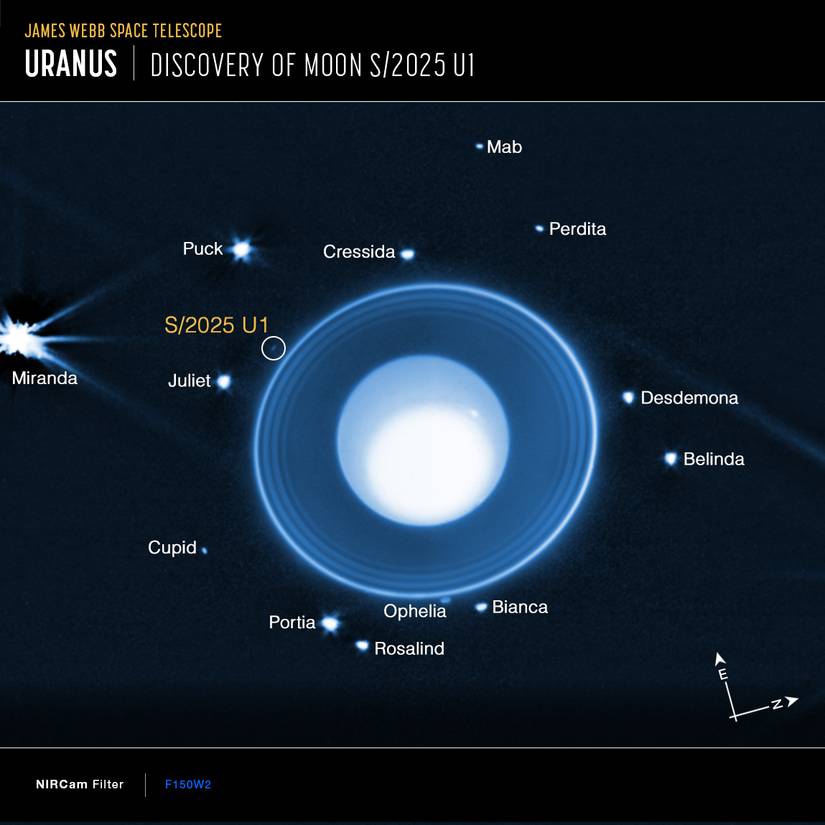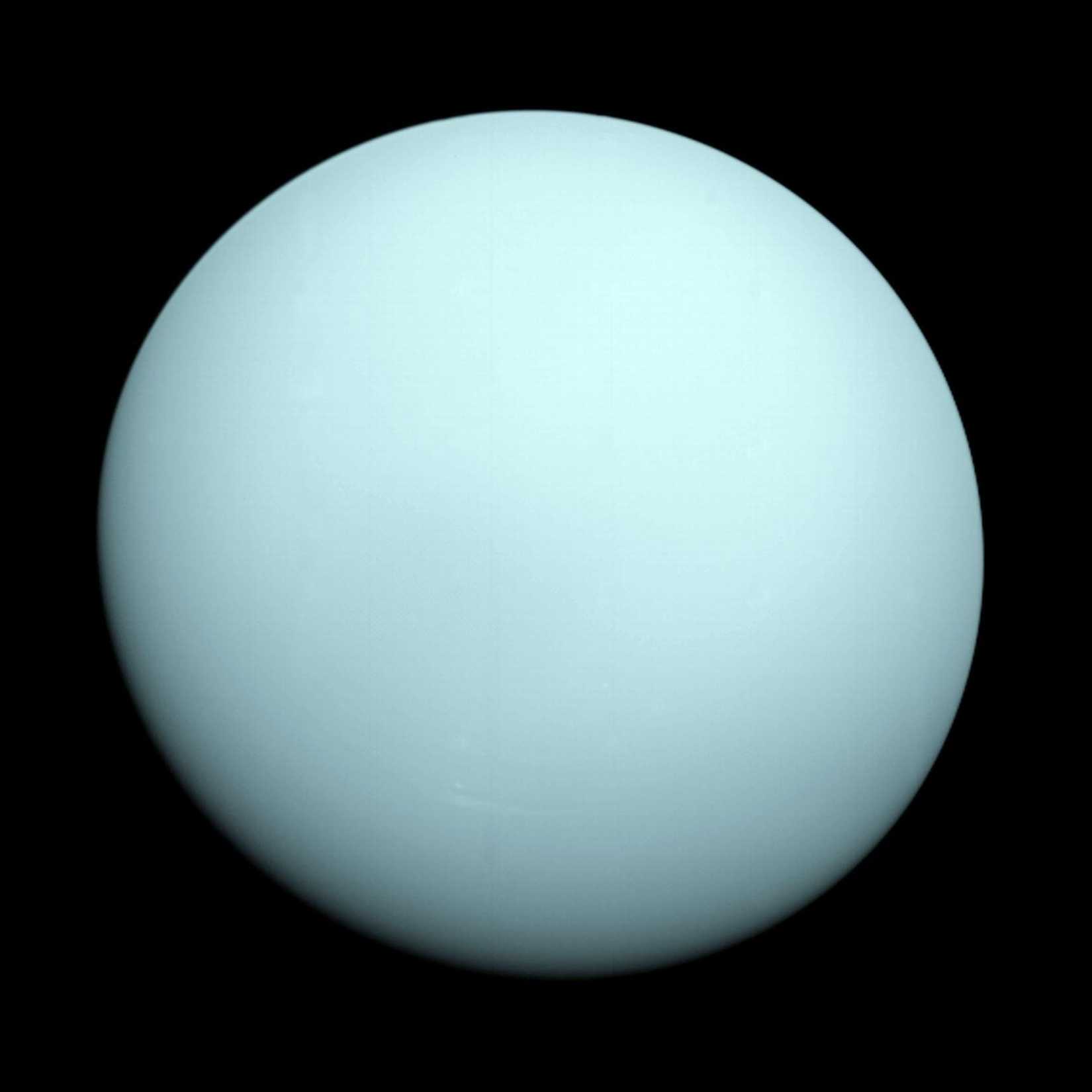Astronomers using NASA’s James Webb Space Telescope have discovered a tiny new moon orbiting Uranus, the first addition to the ice giant’s satellite family in decades. Provisionally named S/2025 U1, the hidden moon was first detected on February 2, 2025, and at just 10 kilometers (six miles) wide it is the smallest moon yet found around Uranus and the smallest in our solar system!
Although the discovery was made months ago, it was only just announced that Uranus now has a 29th known moon. I reached out to Dr. Matthew Tiscareno, a planetary scientist at the SETI Institute in Mountain View, California, who explained, “It takes time to do careful analysis and be very sure of such a momentous announcement.”
That relatively tiny size explains why Voyager 2 completely missed it during its 1986 flyby of the sideways planet, despite having “returned more than 7,000 photographs, revealing 11 new moons, the innermost ones being intricately involved with the ring system, and two new rings orbiting the planet,” writes NASA historian John Uri.
Voyagers 1 and 2, both launched in 1977 on a mission to explore Jupiter and Saturn, and thanks to a rare planetary alignment that occurs once every 175 years, Voyager 2 was able to continue on a trajectory for years to fly past Uranus.
It’s not just the size that kept this moon hidden though, but also its positioning. “JWST is such an amazingly sensitive camera that it actually can see more than Voyager could see, despite the much greater distance,” Matthew Tiscareno tells me. “Also, JWST can see the entire Uranus system at once, while a spacecraft in the middle of the system can only look in one direction at a time.”
The Smallest Moon Ever Discovered
“It’s located about 35,000 miles (56,000 kilometers) from Uranus’ center, orbiting the planet’s equatorial plane between the orbits of Ophelia (which is just outside of Uranus’ main ring system) and Bianca,” said Maryame El Moutamid, the lead on this latest Webb observing program studying the rings and moons of Uranus, said of her discovery. “Its nearly circular orbit suggests it may have formed near its current location.” Tiscareno adds:
“The inner moons of Uranus are a complex and chaotic system. They probably go back and forth between a ring state and a moon state. Examining the orbit of this moon will give us additional insight into that dynamic, like finding one more piece of a jigsaw puzzle.”
For Tiscareno, the most exciting part may be what this discovery implies: there could be more moons still hidden around Uranus. “This is by far the smallest and faintest of the inner moons we’ve discovered, and usually smaller things are more numerous,” he said.
This is probably the first among others.
While the program’s data has yet to undergo the peer-review process, like all Uranus moons, S/2025 U1 will eventually receive a permanent and more fun name, and instead of drawing inspiration from Greek and Roman gods, Uranus’ moons are uniquely named after characters from Shakespeare and Alexander Pope.
Why Uranus Is The Most Unique Planet
With names like Titania, Oberon, Ariel, and Juliet already in use, S/2025 U1 will join an unusually literary celestial family. I asked Tiscareno if he had any ideas in mind but he says they “can’t talk about any suggestions that have been made until the IAU approves them.”
The International Astronomical Union (IAU), over a century old, was formed to promote and safeguard “the science of astronomy in all its aspects, including research, communication, education and development, through international cooperation.”
In addition to its unique moon naming convention, Uranus itself is one of the solar system’s strangest worlds. The ice giant spins on its side with a tilt of nearly 98 degrees, likely the result of a massive collision long ago with an Earth-sized object, according to NASA. This extreme orientation creates the most bizarre seasons in the solar system, with each pole experiencing 21 years of continuous sunlight followed by 21 years of darkness.
One theory reported by National Geographic from research by Alessandro Morbidelli of the Observatory of Côte d’Azur in Nice, France, in 2011 suggests Uranus was hit by two back-to-back impacts, which could explain why the moons and rings also orbit Uranus on the same tilted equator instead of orbiting its poles.
Another study by Yuya Ishizawa of Kyoto University in 2017, conducted hypothesizes that debris from the giant impact may have helped create the moons. Perhaps this is why Uranus’ inner moons are so small.
Uranus features 13 rings and more small inner moons than any other planet, blurring the line between where rings end and moons begin. Nearly four decades after Voyager 2 provided the only close-up look at Uranus, Webb is showing that the sideways planet still holds surprises waiting to be uncovered.
“We want to continue to study its orbit, which will require more observing time from JWST,” Tiscareno explains when I ask about what’s next for studying S/2025 U1. “Only with additional observations can we really unlock what this moon may have to tell us about its history and surroundings in the Uranus system.”
Images courtesy of NASA, ESA, CSA, STScI, and JPL-Caltech.





